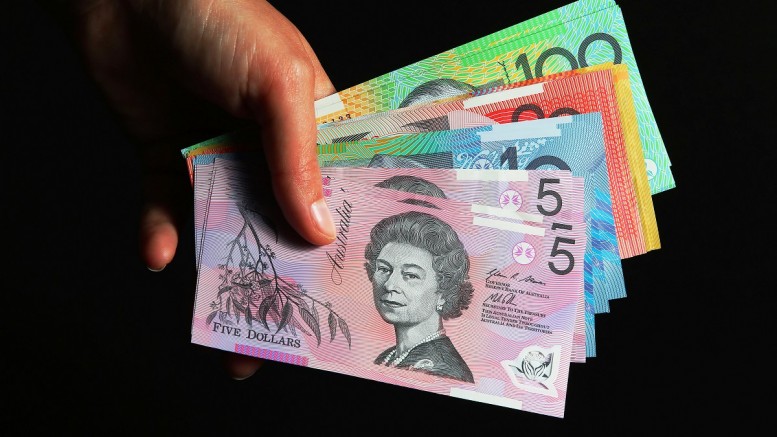 Australians’ average weekly household income grew by A$213 ($170)
between 2004 and 2008. Since then, it’s increased by a total A$27.
Australians’ average weekly household income grew by A$213 ($170)
between 2004 and 2008. Since then, it’s increased by a total A$27.The extremes roughly reflect a surge and fall in export income — as industrializing China sent demand for iron ore and coal rocketing. But despite their stagnant wages, just over a quarter of Aussies have amassed debts equal to three times their income — mostly as housing surged during a central bank easing cycle designed to cushion the end of the mining investment boom.
“Wages growth was very, very strong, but there weren’t the productivity gains to match it, so now it’s very weak because we’re simply not competitive,” said Alex Joiner, chief economist at IFM Investors. “So there needs to be a longer adjustment period, and that’s why you’re probably going to see wage growth only start to bottom out in the next few quarters.” Currency depreciation has helped, he said, but not enough to restore competitiveness.
That suggests little prospect of relief for debt-laden households and puts a cloud over the outlook for consumption that accounts for more than half of gross domestic product — despite a powerful recent labor market performance. In addition to the pincer effect of record debt and low wage growth, households are in line for sharp increases in utilities prices.
In this environment, a Reserve Bank of Australia interest-rate increase remains some way off. In minutes of this month’s policy meeting released Tuesday, the RBA acknowledged risks “from growth in housing debt having outpaced the slow growth in household incomes” in recent years.
“Growth in wages and inflation had remained low but stable,” it said. “This was expected to remain the case for some time. Nevertheless, a gradual increase in growth in wages and inflation was expected as the spare capacity in the labor market was reduced and the economy continued to strengthen, supported by the low level of interest rates.”
The Australian dollar climbed 0.2 percent on Tuesday to buy 79.74 U.S. cents at 3:01 p.m. in Sydney.
A psychological boost may be in the offing. When third-quarter GDP is released in December, the absence of the contraction from a year earlier could lift annual growth close to 3 percent, compared with 1.8 percent in the second quarter. The next wage-price index will also incorporate a 3.3 percent hike in the minimum rate and may lift the gauge above the 1.9 percent record low it’s held at for the past year.
There could be an offsetting counter effect as regulators attempt to cool home lending and bring the property market in to a soft landing. That will probably see house prices stagnate or even drop a bit and put an end to the “wealth effect” home owners enjoyed while prices were rising, which encouraged them to borrow and spend more.
In Retreat
But as sunshine has spread across major economies, leading to the biggest coordinated upswing in seven years, Australia has fallen back to the middle of the pack. Its growth is behind the U.S. and euro zone’s respective 2.2 percent and 2.3 percent, and lower than Canada’s and Germany’s. Australia is still ahead of the U.K., France, Italy and Japan.
“We’re just behind the cycle in other big countries,” said Saul Eslake, an independent economist who has studied Australia’s economy for more than three decades. “Wages aren’t going to pick up until or unless employment picks up by enough to make serious inroads into the spare capacity there is in the labor market. That’s going to take time.”
In the 12 months through June, average earnings in Australia’s national accounts — a broader measure of household income than the wage index — climbed just 0.1 percent, compared with inflation of 1.9 percent, according to the Australian Bureau of Statistics. That raises the question of where demand for consumer spending will come from.
Justin Fabo, a senior economist at AlphaBeta in Sydney, reckons the public sector that accounts for 23 percent of GDP is growing rapidly and playing a significant role. “For a quarter of the economy, that’s providing a big offset to some of the softness,” he said.
Eslake is looking elsewhere. He cites business investment picking up, suggesting that strengthening conditions offshore may finally have encouraged local firms to spend. But his concerns remain on the labor market’s spare capacity. August data showed the quarterly under-utilization rate declined 0.2 percentage point, but still remained at an elevated 14.1 percent.
Bargaining Power
Australia’s problem is that while employment growth is strong, it often involves workers shifting from higher paid mining or construction jobs to lower paid ones. There’s also the workforce’s casualization, according to Joiner. He cited an unnamed company with 500 full-time equivalent roles but only 200 permanent staff, with the remaining employees on rotation.
“In that environment, you’ve got a fair section of the workforce — as in that particular company — that just has very little bargaining power,” Joiner said.
One thing is certain: with rates already at a record-low 1.5 percent, monetary policy can’t do much more for the economy. Households have already done their bit by borrowing to buy properties and are generally maxed out. For businesses, a reluctance to take on debt may reflect their uncertainty about where demand will come from.
As a result, it seems likely that Australian households will just have to battle through in coming quarters.
“We’ll continue to muddle along,” said Fabo. “I can’t see how we get a big breakout in growth from here. I still would’ve thought numbers tracking along around that 2.5 percent mark on average for the next few quarters feels about right.”





















0 comments:
Post a Comment